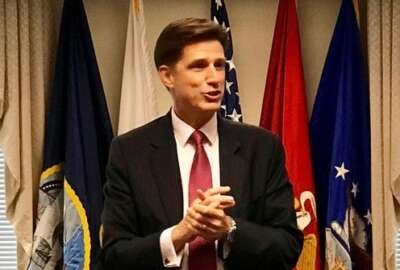
DHS working on enterprise data inventory after workforce vaccination sprint
The COVID-19 pandemic put the Department of Homeland Security in a situation where it needed to get a handle on its workforce data quickly in order to expedite the...
The COVID-19 pandemic put the Department of Homeland Security in a situation where it needed to get a handle on its workforce data quickly, in order to expedite the vaccination of its frontline employees.
DHS Chief Data Officer Mike Horton, a longtime IT official at the agency but new to the CDO job, said these efforts, coordinated under Operation Vaccinate Our Workforce (VOW), required the agency to pull workforce data from a range of disparate systems.
“We can provide the data on the people that we want to get vaccinated, so we took that as our piece. Who are our 1A’s, who are our 1B’s? We sorted all that data [and] found out that data comes from a lot of different places,” Horton said during a recent ATARC webinar.
Since April, DHS vaccinated more than 58,000 of its mission-critical employees — up from only about 5,000 in February. The department worked closely with the Veterans Health Administration and more than 160 of its medical centers to vaccinate its workforce, but that effort required DHS to manage a “coalition of data” from VA and the Department of Health and Human Services.
“Some of our data from HHS came in a totally different system. The same thing goes with VA. They had a very specific way of dealing with data — much more mature than us, at least this high up in DHS. We found ourselves in a situation where we had to sort that data and get it right,” Horton said.
Building off this momentum, Horton said DHS is now moving forward with an enterprise-level data inventory, with the goal of making it easier to gather insights about the state of the workforce or agency operations.
More than a year into the Federal Data Strategy, and two years after Congress passed the Evidence Act requiring agencies to name a chief data officer, CDOs are still carving out their niche in their agencies’ org charts.
“The data thing is not new, but having a chief data officer and integrating that function into the way the organization operates is new,” Navy CDO Tom Sasala said.
While CDOs are a relatively new addition to most agencies, Sasala said his office is building trust with Navy leadership through its work. Through a combination of machine learning, artificial intelligence and data management, Sasala said his office was recently able to dig into the root causes of a shortage of available Navy aircraft.
“We were able to actually make some strategic changes to how we approached aircraft maintenance in general, not just pure availability of aircraft right now. So we are now hitting our maintenance target, we are hitting our availability target, we are now more ready to defend the nation, as it were, but that allows us to now sustain this going forward,” Sasala said.
Over the next 12-18 months, Sasala said he’s focused on breaking down the Navy’s various data silos and making these data sets more interoperable across the service.
Justin Marisco, CDO at the Bureau of the Fiscal Service, said the bureau is also taking steps to modernize its “data footprint,” and is in the early stages of a project aimed at knocking down some of the siloes that prevent internal data sharing.
“Our project that we’re thinking about now is how do we bring all of that data together and instead of deploying an AI tool over here, over here and over here, bring the data together so we can have one thing that works across the organization,” Marisco said.
Damian Kostiuk, chief of the data analytics division at Citizenship and Immigration Services, said his agency is also working on a similar “data lake” concept, which is made all the more necessary, given demand for greater automation.
“If you’ve got a thousand mistakes that can be made very quickly because your data quality suddenly goes very bad, well if you have that all splayed out in different siloed data sets all over the place, how hard is that going to be to try and correct the data quickly so you can get back your operations? It’s really difficult, so you want to have it concentrated in a single space. Maybe that’s part of that culture change, that’s hard for some people to get over, because they like having their little siloes, and they like having their direct control, but the reality is that’s not very functional when we get to a high-speed AI ML world,” Kostiuk said.
Kostiuk said AI and machine learning serve as force multipliers for the agency’s workforce, but said the agency needs safeguards that can flag data quality errors quickly in order to build trust and greater adoption of these tools
“There’s a lot more risk to making a big mistake real fast,” Kostiuk said.
In standing up this data infrastructure, Marsico said CDOs are serving as a “change agent” for their agencies.
“A common experience for many CDOs in government is that we are either standing up an office, or we have been standing up an office and now we’re trying to get to the next step of what operations look like. There’s a lot of administrative stuff that comes with that,” Marsico said.
Copyright © 2025 Federal News Network. All rights reserved. This website is not intended for users located within the European Economic Area.
Jory Heckman is a reporter at Federal News Network covering U.S. Postal Service, IRS, big data and technology issues.
Follow @jheckmanWFED





